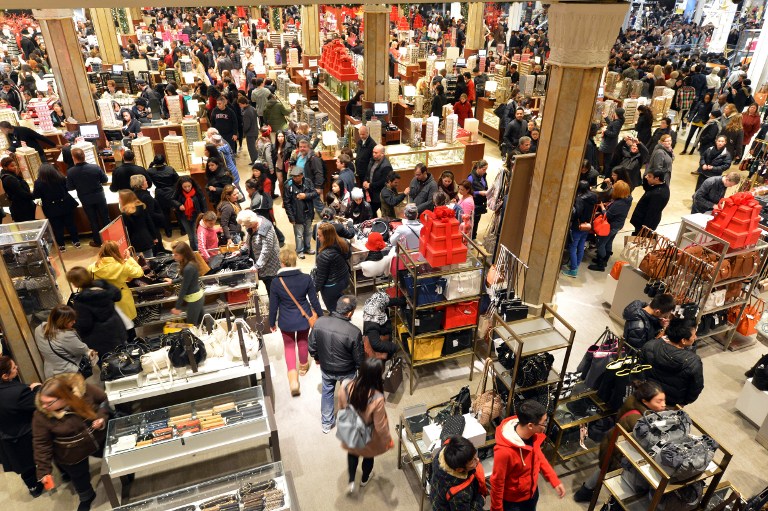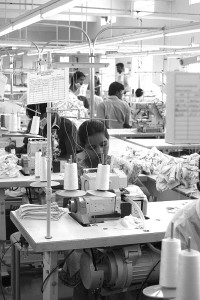
It is no secret that our aggressive consumption behavior causes pollution and climate change, but we rarely think of our clothing as a main culprit. Actually, 10% of global carbon emissions come from textiles, the second largest polluting industry in the world. There are two causes for apparel’s huge environmental impact: the processes used to manufacture clothing, and growing over-consumption of clothing. Brands small and large are beginning to integrate more sustainable practices into global supply chains, but global civil society must be energized on the issue to bring about tangible change more quickly.
Processes that pollute
According to the World Bank, dying and treating textiles accounts for about 20% of all industrial water pollution in the world; only agriculture is responsible for more. This is partly because convention cotton farming relies largely on pesticides, creating runoff and contaminating water sources. Processing cotton for clothing also uses large volumes of water – 2700 liters per t-shirt – much of which is contaminated by toxic chemicals that cannot be filtered out. This renders the water permanently useless for human purposes, which is alarming considering that global fresh water usage doubles every 20 years. It is already projected that by 2025, one third of all people will live in drought-prone areas. We should be doing all we can to conserve this increasingly scarce resource, but as it is, something as integral to our lives as our clothing undermines conservation efforts.
Of course, in the West it is easy to overlook the realities of textile production when we do not directly witness its environmental harms. Much of it happens elsewhere, in developing regions of the world whose cheap labor allow them to become hubs for textile manufacturing. When the industry moves into a region, it brings new work opportunity, higher wages and a better quality of life, but not without costs.
Tirapur, India, is the perfect example of textile manufacturing success story turned ecological disaster. In 2002, the US government began investing heavily in Indian textiles. Much of the money went toward a pipeline to bring clean water from the Noyyal River to the Tirapur region, sparking a boom in textile manufacturing there. While this boom brought new employment and, somewhat ironically, access to clean water for the local population, manufacturing also polluted the water heavily. Tirapur’s farmland has become unusable from the toxic chemicals in the water used for irrigation, and an estimated 30% of locals suffered from symptoms of waterborne disease. This is hardly surprising, considering that each day, 23 million gallons of wastewater poured into the Noyyal River. When Tirapur’s dam was flushed in the mid-2000s, locals found 400 tons of dead fish at the bottom.

Such accounts are sobering for those who believe in globalization and free trade as the path to global economic development and poverty reduction. Because of intense demand for cheap clothing, the choice to enforce strict labor and environmental regulations often means losing investment inflows for a developing country. At the root of the issue, then, lies Western appetite for fast fashion: the incessant need to update our wardrobes on the ever-more-quickly changing whims of fashion trends.
Fast fashion
According to Pamela Ellsworth, chairwoman of the Fashion Institute of Technology’s Global Fashion Management Program, the main responsibility for the perpetuation of environmentally damaging practices lies with Western consumers. People demand low priced fashion but also expect corporate responsibility, but the truth of the matter is that it is nearly impossible for companies to minimize pollution, pay fair wages at each stage of production and still sell $15 t-shirts. “Eventually we are going to have to train consumers in the US to pay more for clothing,” Ellsworth said. “It can’t be the only commodity that gets cheaper every year.”
Currently, more than 150 billion garments are produced globally each year, more than 20 new pieces of clothing per person. Of course, these disproportionately fall into Western closets, suggesting that the average Westerner purchases far more than 20 new garments per. Americans alone are guilty of throwing away, on average, 70lbs of clothing per person annually. This points to an attitude that clothing is seasonal and disposable – which it is, when prices stay low enough to regularly throw out and replace garments.
This attitude is fueled by the corporate trend toward fast fashion. Once upon a time, the fashion world operated on four seasons, but the industry is accelerating rapidly. Now, retail giants like Zara, Adidas and H&M put out new styles as often as 15 times per year. To sustain this frenzied pace, 97% of America’s clothing is manufactured abroad (as of 2015), compared with only 5% in 1960. And even though clothing prices fall each year, fast fashion companies continue to grow and regularly rake in the industry’s highest profits.
Even despite rising awareness of the environmental and ethical issues of fast fashions, those brands continue raking in profits while companies founded on values of sustainability struggle to compete (Patagonia is a notable exception). For instance, American Apparel and Nasty Gal have both recently filed for bankruptcy. Though not to minimize the multifaceted nature of their demise, it is worth noting that both brands kept most of their production in the US. This meant offering styles and quality comparable to clothing that consumers could buy at retailers like Zara and H&M for a fraction of the price. Speaking to the Observer, Edward Hertzman, apparel and textile supply chain expert, summed up the depressing conclusion here: though most will not admit it, companies constantly face “intense pressure from their clients to lower the price,” making investing in sustainability or ethical practices impractical if not impossible.

Not only do consumers want their clothes cheap, but they also want them now. In 2015, more and more companies adopted fast-fashion business models, fashioning themselves in Zara’s image to emulate the success of the biggest fashion retailer in the world. Retailers like Spanish brand Mango focus on “speed and immediacy” to please consumers who view fashion as another instant and ephemeral form of entertainment. Together, the demand for cheap prices and immediacy perpetuate the fast fashion industry and its unsustainable practices.
Not so fast: possible solutions to a rising catastrophe
The most obvious solution to the problems posed by fast fashion is for consumers to change their behavior: support sustainable and ethical brands, buy fewer garments and keep or donate them instead of throwing old clothes away. This is easier said than done; despite rising trends toward sustainable and second-hand fashion, the vast majority of shoppers prefer lower prices. And as long as cheap, disposable fashion remains available, consumers have no economic incentive to change their behavior.
Instead of waiting for their customers to adopt more environmentally conscious values, multinational corporations have the power to make more immediate change. Many have already taken steps toward sustainability; for instance, H&M allows customers to bring in used clothing to be recycled into new garments to meet the company’s goal of “zero garments going to landfill.” Brands like the Reformation are helping make sustainability cool by providing “killer clothes that don’t kill the environment.” Even Adidas recently released a shoe made from recycled ocean plastic, though at a retail price of $220, it is unlikely to become a brand staple. Rather, it represents a symbolic gesture towards sustainability that Adidas and its consumers can flaunt while avoiding making any fundamental changes to their supply chain. This exemplifies a caveat of sustainability efforts by fast fashion giants: more often than not, they are merely publicity stunts, a drop in the bucket compared to the company’s entire ecological footprint.
The environmental catastrophe of the textile industry is a textbook example of the negative ramifications of unchecked global capitalism; if we wait for market forces to push for more sustainability, change will be slow and the consequences dire. We can argue about where the moral responsibility lies, but the fact remains that both consumers and multinationals have proven themselves unwilling to spark change on a macro level.
The best bet for progress would involve governance on national and international levels. On the domestic level, governments can impose more stringent labor and environmental regulations on imports, allowed for in the WTO. In terms of global governance, however, the WTO promotes free trade as a means to sustainable development, though as we have seen the evidence shows that this is not always the case.
Bilateral and multilateral trade agreements also provide an opportunity to strengthen environmental governance, but more often free trade agreements (FTAs) have the opposite effect. Most recently, both the Transpacific Trade Partnership (TTP) and Transatlantic Trade and Investment Partnership (TTIP) proposed to expand investment rules that allow corporations to sue host governments in private trade tribunals when they feel cheated of profit by domestic rules or regulations. Already, multinationals have great power to levy such complaints, and tend to win lawsuits. This then reduces countries’ ability to create and enforce strong environmental protections, especially small, developing countries.
Already environmental standards in developing countries, home to the majority of textile production, are weak and often overlooked. However, the blame rests with the countries that import their garments, not with poor countries made to choose between allowing in the textile industry and turning down a chance at growth and development. In fact, while developed countries used to be the main instigators of trade protection in the textile industry, today developing countries are more proactive in pushing for them. This reflects shifting motives for trade protection, from anti-dumping to environmental and labor protection.
A 2009 World Bank report notes that social and environmental regulations are emerging as more important barriers to trade than ever before and recommends more action in this sphere. However, no Western government wants to put in place protections that will deprive its citizens of cheap imported clothing. Most existing regulations refer to labeling but do not actually set guidelines for which products can or cannot enter into the country, nor do they govern corporations’ practices abroad. As such, current moves toward sustainability and fair trade in the industry originate from the corporations themselves, but as discussed, it is difficult to pursue these goals without compromising profitability.
The current situation is a classic chicken and egg dilemma, but with three players: global civil society, textile and apparel multinationals, and domestic governments. If any one of these actors drastically shifted its approach, the others would follow. However, one of these must make the first leap toward rectifying the social and environmental disaster of clothing, but none wants to make the first move before gaining the others’ support. The issue is clear, but not the way forward.
The views expressed by the author do not necessarily reflect those of the Glimpse from the Globe staff, editors or governors.






